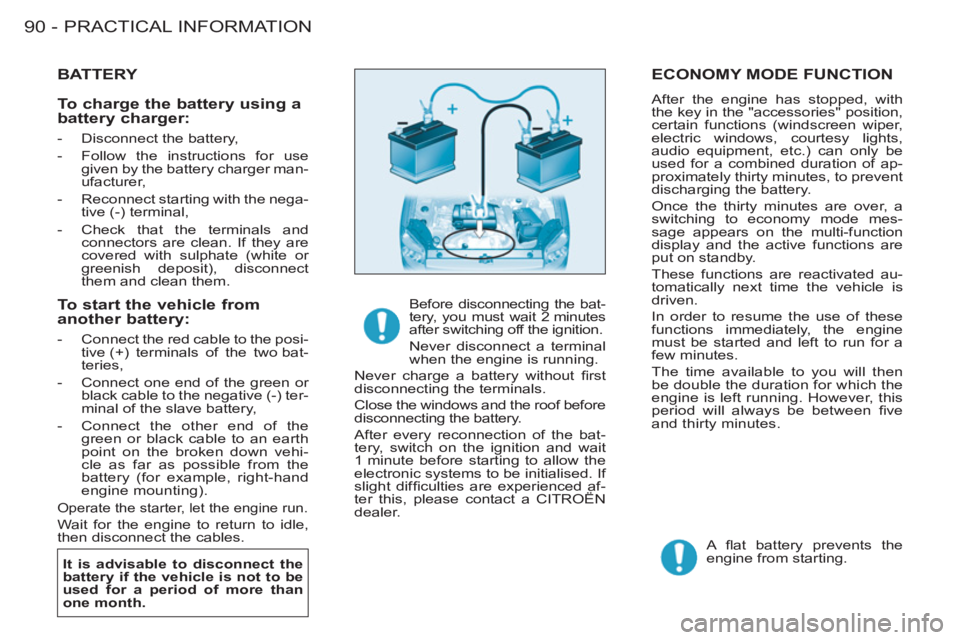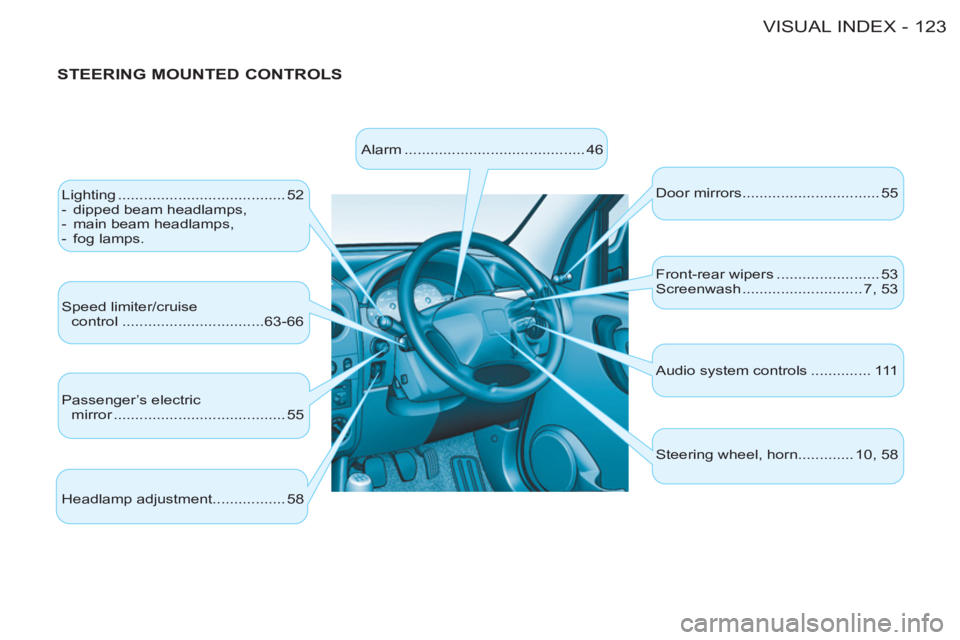light CITROEN BERLINGO FIRST 2011 Handbook (in English)
[x] Cancel search | Manufacturer: CITROEN, Model Year: 2011, Model line: BERLINGO FIRST, Model: CITROEN BERLINGO FIRST 2011Pages: 132, PDF Size: 5.67 MB
Page 89 of 132

87 PRACTICAL INFORMATION
-
Fuse
Rating
Functions
1
15A
Rear wiper.
4
20A
Multi-function scren - Instrument panel -
Audio system - Steering mounted controls.
5
-
Not used.
6
10A
Diagnostic socket.
7
-
Not used.
9
30A
Heated seats.
10
40A
Rear window and door mirrors demisting.
11
15A
Rear wiper (tailgate).
12
30A
Front electric windows.
14
10A
Engine fusebox - Steering mounted controls.
15
15A
Instrument panel - Multi-function screen -
Audio system.
16
30A
Locking/unlocking controls for doors,
bonnet and boot.
20
10A
Right-hand brake lamp.
21
15A
Left-hand brake lamp.
22
20A
Front courtesy lamp - Map reading lamp -
Cigarette lighter - Electric mirror.
Page 92 of 132

PRACTICAL INFORMATION
90 -
ECONOMY MODE FUNCTION
After the engine has stopped, with
the key in the "accessories" position,
certain functions (windscreen wiper,
electric windows, courtesy lights,
audio equipment, etc.) can only be
used for a combined duration of ap-
proximately thirty minutes, to prevent
discharging the battery.
Once the thirty minutes are over, a
switching to economy mode mes-
sage appears on the multi-function
display and the active functions are
put on standby.
These functions are reactivated au-
tomatically next time the vehicle is
driven.
In order to resume the use of these
functions immediately, the engine
must be started and left to run for a
few minutes.
The time available to you will then
be double the duration for which the
engine is left running. However, this
period will always be between fi ve
and thirty minutes.
BATTERY
It is advisable to disconnect the
battery if the vehicle is not to be
used for a period of more than
one month.
Before disconnecting the bat-
tery, you must wait 2 minutes
after switching off the ignition.
Never disconnect a terminal
when the engine is running.
Never charge a battery without fi rst
disconnecting the terminals.
Close the windows and the roof before
disconnecting the battery.
After every reconnection of the bat-
tery, switch on the ignition and wait
1 minute before starting to allow the
electronic systems to be initialised. If
slight diffi culties are experienced af-
ter this, please contact a CITROËN
dealer.
A fl at battery prevents the
engine from starting.
To start the vehicle from
another battery:
- Connect the red cable to the posi-
tive (+) terminals of the two bat-
teries,
- Connect one end of the green or
black cable to the negative (-) ter-
minal of the slave battery,
- Connect the other end of the
green or black cable to an earth
point on the broken down vehi-
cle as far as possible from the
battery (for example, right-hand
engine mounting).
Operate the starter, let the engine run.
Wait for the engine to return to idle,
then disconnect the cables.
To charge the battery using a
battery charger:
- Disconnect the battery,
- Follow the instructions for use
given by the battery charger man-
ufacturer,
- Reconnect starting with the nega-
tive (-) terminal,
- Check that the terminals and
connectors are clean. If they are
covered with sulphate (white or
greenish deposit), disconnect
them and clean them.
Page 96 of 132

PRACTICAL INFORMATION
94 -
TOWING A TRAILER,CARAVAN, BOAT, ETC.
We recommend the use of original
CITROËN towbars and their har-
nesses that have been tested and
approved from the design stage of
your vehicle and that the fi tting of the
towbar is entrusted to a CITROËN
dealer.
If the towbar is not fi tted by a
CITROËN dealer, it is imperative that
it is fi tted using the electrical pre-
equipment installed at the rear of the
vehicle, in accordance with the man-
ufacturer's instructions.
Your vehicle is primarily designed
for transporting people and luggage
but it may also be used for towing a
trailer.
Driving with a trailer subjects the tow-
ing vehicle to more signifi cant stress
and its driver must be particularly
careful.
Air density decreases with altitude,
thus reducing engine performance.
Above 1 000 metres, the maximum
towing load must be reduced by 10 %
and so on for every 1 000 metres of
altitude.
Driving advice
Tyres:
Check the tyre pressures of
the towing vehicle and of the trailer,
observing the recommended pres-
sures.
Braking:
Towing increases the braking
distance.
Lights:
Check the electrical signalling
on the trailer.
Side wind:
Take into account the
increased sensitivity to side wind.
Cooling:
Towing a trailer on a slope
increases the temperature of the
coolant.
As the fan is electrically controlled,
its cooling capacity is not dependent
on the engine speed.
On the contrary, use a high gear to
lower the engine speed and reduce
your speed.
The maximum towing load on a long
slope depends on the gradient and
the outside temperature.
In all cases, pay attention to the coolant
temperature.
In certain cases of particularly ardu-
ous use (towing the maximum load on
a steep gradient in high temperatures),
switching off the air conditioning permits
the recovery of engine power and there-
fore an increase in the towing capacity.
If the warning light comes on, stop
the vehicle and switch off the engine
as soon as possible.
Distribution of loads:
Distribute the
load in the trailer so that the heaviest
items are as close as possible to the
axle and the nose weight approach-
es the maximum permitted without
exceeding it.
Page 99 of 132

97 TECHNICAL DATA
-
Light van
Ludospace
L1
4 137
L2
4 437
-
H
1 796 to 1 819
1 810
A
2 693
B
836
C
608
D
570
550
E
1 440
1 440 or 1 452
F
1 960
G
1 420
1 420 or 1 436
I
1 724
Page 100 of 132

TECHNICAL DATA
98 -
INTERIOR DIMENSIONS (IN MM) AND VOLUMES (IN M3) LIGHT VAN
L1
L2
J
1 155
K
1 320
M
1 190
N
1 190
O
568
P
1 340
1 640
m
3
3.25
3.6
Page 106 of 132

TECHNICAL DATA
104 -
Engine
1.4 litre
Gearbox
Manual
Model codes
GB KFWC
GC KFWC
GD KFWC
GA KFWC
Length
L1
L2
Version (kg)
600
800
750
1 000
●
Kerb weight
1 055
1 080
1 116
●
Gross vehicle weight (GVW)
1 655
1 855
1 830
2 145
●
Gross train weight
2 555
2 755
2 740
2 880
●
Unbraked trailer
500
575
575
●
Braked trailer (within GTW)
900
910
735
●
Recommended nose weight
70
75
75
●
Recommended weight on roof rack
100
100
100
The GTW and towing load values indicated are valid up to a maximum altitude of 1 000 metres; the towing load mentioned
must be reduced by 10 % for each additional 1 000 metres.
The speed of a towing vehicle must not exceed 60 mph (100 km/h) (comply with the legislation in force in your country).
High exterior temperatures may result in a reduction in the performance of the vehicle in order to protect the engine; when
the exterior temperature is above 37 °C, limit the towed load.
PETROL WEIGHTS AND TOWING LOADS (IN KG) FORLIGHT VAN
Page 107 of 132

105 TECHNICAL DATA
-
DIESEL WEIGHTS AND TOWING LOADS (IN KG) FOR LIGHT VAN
Engine
1.6 litre Turbo HDI 75
1.6 litre Turbo 92
1.9 litre
Gearbox
Manual
Manual
Manual
Model codes
GB
9HWC
GC
9HWC
GD
9HWC
GA
9HWC
GB
9HXC
GC
9HXC
GD
9HXC
GA
9HXC
GB
WJYB
GC
WJYB
GD
WJYB
GA
WJYB
Length
L1
L2
L1
L2
L1
L2
Version (kg)
600
800
750
1 000
600
800
750
1 000
600
800
750
1 000
●
Kerb weight
1 130
1 144
1 140
1 130
1 140
1 144
1 206
1 142
1 146
●
Gross vehicle weight
1 730
1 930
1 895
2 180
1 730
1 930
1 900
2 140
1 805
1 955
1 895
2 180
●
Gross train weight
2 830
3 030
3 005
3 005
2 830
3 030
3 005
3 005
2 855
3 055
3 005
3 005
●
Unbraked trailer
500
585
585
500
585
585
500
585
585
●
Braked trailer
(within GTW)
1 100
1 110
850
1 100
1 110
865
1 050
1 100
1 110
825
●
Recommended nose
weight
70
75
75
70
75
75
70
75
75
●
Recommended
weight on roof rack
100
100
100
100
-
The GTW and towing load values indicated are valid up to a maximum altitude of 1 000 metres; the towing load mentioned
must be reduced by 10 % for each additional 1 000 metres.
The speed of a towing vehicle must not exceed 60 mph (100 km/h) (comply with the legislation in force in your country).
High exterior temperatures may result in a reduction in the performance of the vehicle in order to protect the engine; when
the exterior temperature is above 37 °C, limit the towed load.
Page 112 of 132

110
01
1
22
10101111
133144155
33445566778899
122
FIRST STEPS
1. On/Off and volume adjustment.
2. CD eject.
3. Selection of the display on the screen:
Audio (AUDIO) functions.
4. Selection of source:
radio, audio CD/MP3 CD.
5. Selection of FM1, FM2, FMast and AMwavebands.
6. Setting audio options: front/rear fader, left/right balance, loudness, sound ambience.
7. Display the list of local stations, of thetracks on the CD or of the MP3 folders.
8. Abandon current operation.
9. TA (Traffi c Announcement) function on/off.
Long press: access to the PTY (Types of radio programme) mode.
10. Confi rmation.
11. Automatic search for a lower/higher frequency.
Selection of previous/next CD, MP3 track.
12. Selection of a lower/higher radio frequency.
Selection of the previous/next MP3 folder.Selection of the previous/next USB devicefolder/genre/artist/playlist.
13. Display the main menu.
14. Buttons 1 to 6:
Selection of a stored radio station.
Long press: store a station.
15. The DARK button changes the display in the screen to improve driving comfort at night.
1st press: lighting the upper band only.
2nd press: display of a black screen.
3rd press: return to the standard display.
Page 125 of 132

123 VISUAL INDEX-
STEERING MOUNTED CONTROLS
Lighting ....................................... 52
- dipped beam headlamps,
- main beam headlamps,
- fog lamps.
Speed limiter/cruise
control .................................63-66
Passenger’s electric
mirror ........................................ 55 Door mirrors ................................ 55
Headlamp adjustment................. 58 Alarm .......................................... 46
Audio system controls .............. 111 Front-rear wipers ........................ 53
Screenwash ............................ 7, 53
Steering wheel, horn............. 10, 58
Page 126 of 132

VISUAL INDEX124 -
INTERIOR
Stowing rings ........................ 15, 59
Child seats .............................36-41 Front seats.............................32-33
Seat belts...............................42-43 Airbags ..................................67-69 Multifunction passenger seat ...... 34
Child lock (door) ......................... 49
Partially opening rear windows....... 54 Courtesy lamp, interior
lighting .................................56-57 Rear seats (5 seat version) ........ 35
Rear fi ttings .....................15, 60-61
- stowing rings,
- storage tray,
- hooks,
- retaining net,
- storage pocket,
- storage compartments.